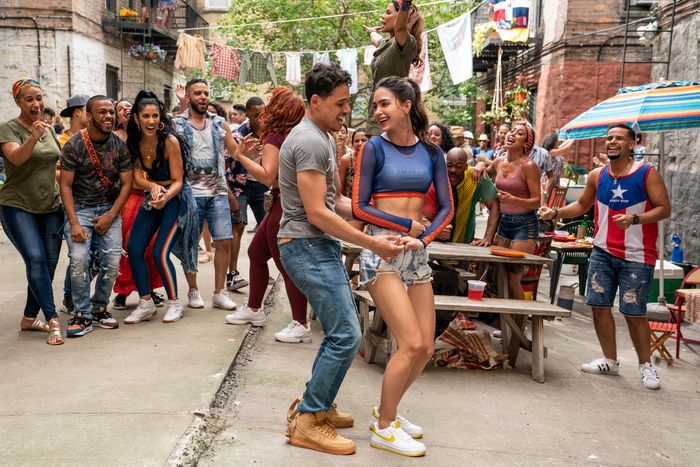
Last March, In the Heights wound up being the last film I saw in a theater before COVID-19 shut down New York. I had just arrived at a press screening when I learned that our physical office was closing and that everyone would work from home until further notice. This made watching the movie a bittersweet experience. The vision of community, the sweaty intimacy of crowded street corners and apartments and clubs, the revolving door of neighbors and friends drifting through each other’s days like surrogate family, not to mention an enduring, frustrated love for the tousled grandeur of the city itself — all these things, even the very idea of them, felt like they were quickly receding into the past, with little insight into when they might, if ever, return.
Of course, even without a pandemic, In the Heights (now out in theaters and on HBO Max, after a year of delays), directed by Jon M. Chu from Lin-Manuel Miranda’s hit musical love letter to the largely Dominican neighborhood of Washington Heights, was already suffused with a gentle melancholy — not exactly nostalgia, but a sense of things passing. There’s a fairy-tale retrospection built into the film’s framing device, as our hero, Usnavi (Anthony Ramos), sits at an idyllic beachside bar talking to a group of kids about “a faraway land called Nueva York” and a “barrio called Washington Heights.” (“Say it, so it doesn’t disappear,” he implores them.) His story centers on what would have been his last days in New York, as he prepares to leave behind the bodega he has run for most of his life and return to the Dominican Republic to restore his late father’s beloved bar. The neighborhood is changing, gentrification is encroaching, and Usnavi is tired of slaving away just to make ends meet. Once upon a time, moving to America meant a better life; now, it seems like you must leave to improve your lot.
The bar he hopes to reopen is called “El Sueñito” — “Little Dream” — and the film’s four protagonists all have their distinct little dreams, each revealing a different relationship to this community. Usnavi wants to go back to his family’s homeland, where he believes he spent the best days of his life as a child; Vanessa (Melissa Barrera), the aspiring designer Usnavi not-so-secretly longs for, intends to move downtown to open her own fashion store in the West Village; Nina Rosario (Leslie Grace) has just returned from a tumultuous first year at Stanford determined not to go back but also mortified of disappointing all the family and neighbors who had such high hopes for her; Usnavi’s best friend Benny (Corey Hawkins), who has feelings for Nina Rosario, wants to continue diligently working for the car service owned by her father Kevin (Jimmy Smits), a situation complicated by the fact that Kevin is thinking of selling the business to help pay for his daughter’s tuition.
This quartet of young lovers drives the story, but they’re just part of the expansive tapestry on display. The film’s numbers, drawn from a wide range of musical styles, rarely follow a single emotional through line, instead presenting entire symphonies of character, gesture, and subplot. The movie was shot on location in Washington Heights, lending it an immediacy that makes for a vibrant, occasionally dissonant combination with the outsized aesthetic of a studio musical. Chu simultaneously blends the casual, the lived-in and intimate with a traditional musical’s broad gestures and precise rhythms and dream logic, as the actors flip easily between the naturalistic and the theatrical.
That idea is certainly not new, but it doesn’t always work this well. The film has several show-stoppers, with the best one coming right in the middle, as news that Usnavi’s bodega sold a winning lottery ticket that will pay out $96,000 percolates through the crowd at a giant public pool. Everybody sings, in their own style and cadence, about what they would do with such a sum. Throwaway dance moves, bits of slapstick, glimpses of gritty sincerity are cut against grand, highly coordinated movements. It’s like Busby Berkeley by way of Vittorio De Sica. The musical miniatures within the grander scheme make the individual singers’ hopes and fears palpable, but when the camera pulls out and we see the whole pool rise up for the chorus, the effect is overwhelming, as if the power of a thousand dreams has somehow transformed reality itself.
This sort of informal awkwardness clashing against exacting choreography is the film’s sweet spot. (It’s also where Chu has always thrived, as his lovely entries in the Step Up series demonstrated years ago.) It works during the film’s softer moments, too. Late in the movie, when two of our young lovers dance gently and vertically along the side of an apartment building, the moment startles not for technical reasons — it’s the simplest of effects — but because the dancers are clearly experiencing the wonder of what they’re doing, as if surprised that their emotions have allowed them to defy the laws of gravity. They’re in love, and they’re a little freaked out by how it has literally upended their world. Push too far in either direction — make the dancers too confident, or make them too hesitant — and the scene would lose its charm. Their uncertainty heightens their grace, which in turn heightens their humanity. The same could be said for In the Heights itself, which achieves a ramshackle beauty all its own.


